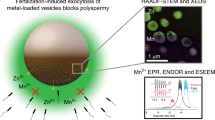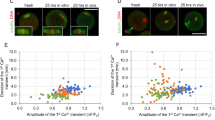Abstract
A dramatic rise in cytoplasmic free Ca2+ concentration has been shown to occur during fertilization and artificial activation in the oocytes of both the medaka fish1 and sea urchin2. Indirect evidence has implicated Ca2+ in the parthenogenetic activation of mammalian oocytes. Mouse oocytes can be activated by the intracellular injection of Ca2+ but not Mg2+ (ref. 3), and hamster oocytes by exposure to the calcium ionophore, A23187 (ref. 4). We report here measurements of cytoplasmic free Ca2+ during the artificial activation and fertilization of single mouse oocytes injected with the Ca2+-sensitive photoprotein aequorin. Free Ca2+ rises exponentially from a resting level of below 0.1 µM to >5 µM over a period of 10–30 min. A series of oscillatory Ca2+ transients precedes this Ca2+ rise during fertilization, but not during artificial activation.
This is a preview of subscription content, access via your institution
Access options
Subscribe to this journal
Receive 51 print issues and online access
$199.00 per year
only $3.90 per issue
Buy this article
- Purchase on Springer Link
- Instant access to full article PDF
Prices may be subject to local taxes which are calculated during checkout
Similar content being viewed by others
References
Gilkey, J. C., Jaffe, L. F., Ridgway, E. B. & Reynolds, G. T. J. Cell Biol. 76, 448–466 (1978).
Steinhardt, R., Zucker, R. & Schatten, G. Devl Biol. 58, 185–196 (1977).
Fulton, B. P. & Whittingham, D. G. Nature 273, 149–151 (1978).
Steinhardt, R. A., Epel, D., Carroll, E. J. & Yanagimachi, R. Nature 252, 41–43 (1974).
Cobbold, P. H. in Detection and Measurement of Free Ca2+ in Cells (eds Ashley, C. C. & Campbell, A. K.) 245–256 (Elsevier, Amsterdam, 1979).
Baker, P. F., Hodgkin, A. L. & Ridgway, E. B. J. Physiol., Lond. 218, 709–755 (1971).
Cobbold, P. H. Nature 285, 441–446 (1980).
Cuthbertson, K. S. R. thesis, Univ. London (1982).
Surani, M. A. H. & Kaufman, M. H. Devl Biol. 59, 86–90 (1977).
Whittingham, D. G. & Siracusa, G. Expl Cell Res. 113, 311–317 (1978).
Miyazaki, S. & Igusa, Y. Nature 290, 702–704 (1981).
Goodwin, B. C. Adv. Enzyme Regulation 3, 425–438 (1965).
Whittingham, D. G. in Oxford Reviews in Reproductive Biology Vol. 2 (ed. Finn, C. A.) 205–231 (Oxford University Press, 1980).
Martell, A. E. & Smith, R. M. Critical Stability Constants Vol. 1 (Plenum, New York, 1974).
Baker, P. F. & Schapira, A. H. V. Nature 284, 168–169 (1980).
Whittingham, D. G. J. Reprod. fert. Suppl. 14, 7–21 (1971).
Author information
Authors and Affiliations
Rights and permissions
About this article
Cite this article
Cuthbertson, K., Whittingham, D. & Cobbold, P. Free Ca2+ increases in exponential phases during mouse oocyte activation. Nature 294, 754–757 (1981). https://doi.org/10.1038/294754a0
Received:
Accepted:
Issue Date:
DOI: https://doi.org/10.1038/294754a0
This article is cited by
-
The zinc transporter ZIP9 (Slc39a9) regulates zinc dynamics essential to egg activation in zebrafish
Scientific Reports (2020)
-
Derivation and maintenance of mouse haploid embryonic stem cells
Nature Protocols (2019)
-
Rab3A, Rab27A, and Rab35 regulate different events during mouse oocyte meiotic maturation and activation
Histochemistry and Cell Biology (2016)
-
Development and imprinted gene expression in uniparental preimplantation mouse embryos in vitro
Molecular Biology Reports (2015)
-
Developmental potency of pre-implant parthenogenetic goat embryos: effect of activation protocols and culture media
In Vitro Cellular & Developmental Biology - Animal (2014)
Comments
By submitting a comment you agree to abide by our Terms and Community Guidelines. If you find something abusive or that does not comply with our terms or guidelines please flag it as inappropriate.



